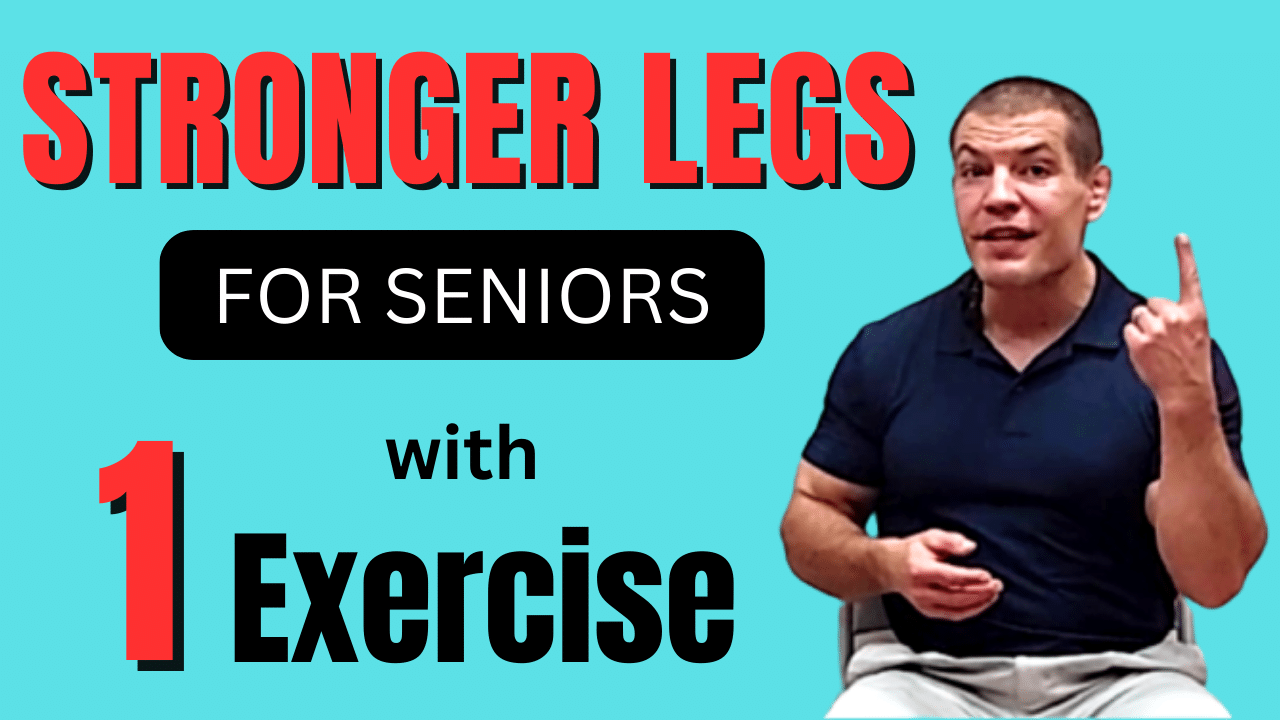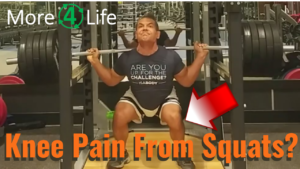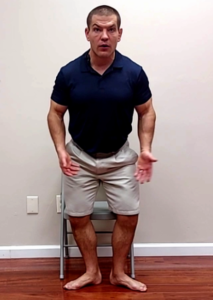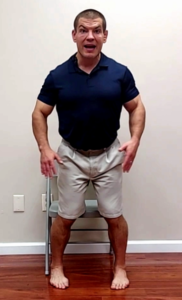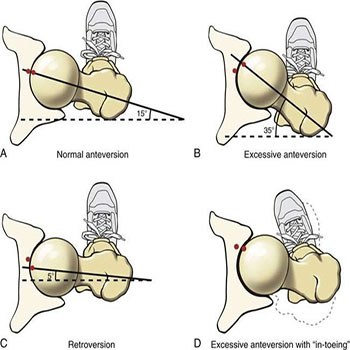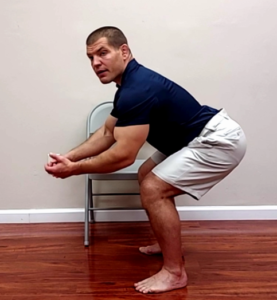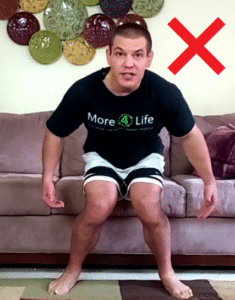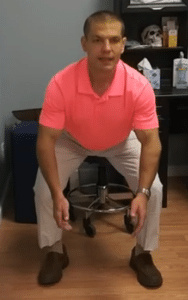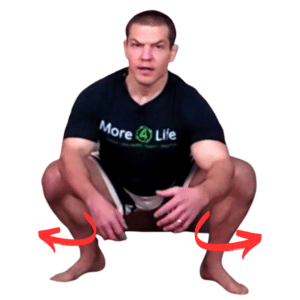What's The Best Leg Strengthening Exercise For Seniors?
The number one best leg strengthening exercise for seniors is absolutely the squat. Watch to video to learn why, plus how seniors can learn to do squats comfortably, even if they have knee arthritis.
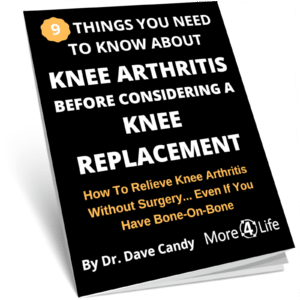
Why Are Squats The Best Leg Strengthening Exercise For Seniors?
The reason that squats are the best leg strengthening exercise for seniors is that is that you squat every single day.
From getting out of a chair, getting off the toilet, getting out of bed, stooping down to pick something up off the floor, stooping down to get something from the cabinets underneath the counter... all of those require some version of a squat.
Are Squats Bad For Your Knees?
Even though squats are the best leg strengthening exercise for seniors, a lot of seniors find it difficult to do a squat.
That may be due to knee arthritis, hip arthritis, or back pain. It can be painful for some seniors to do squats... but usually that's correctable with proper technique.
Furthermore, sometimes their doctors even tell them, "You should never squat," particularly if you have knee arthritis.
Or if you've had a back problem, doctors will tell you not to do a squat at the gym where you load weight on your spine.
However, sometimes people will take that to mean that they should never squat.
But squatting is a very functional exercise.
You need to be able to do it for many different tasks.
So, wouldn't it be nice if you were able to squat without pain?
How Seniors Can Do Squats Without Pain
Most seniors can do squats... even if they have knee arthritis. It's just a matter of finding the proper technique that works for their body.
Squats aren't a one-size-fits-all exercise
In this post, I'll describe 3 different versions of a squat that seniors can do. I'll start with the easiest version and end with the most complex version.
Squatting For Seniors: Choosing The Right Stance
With any squat, it's important to first get your stance correct because not everyone is designed to squat with their toes pointing straight ahead.
If you naturally stand and your feet point out a little bit, then you're going to need to toe out a little bit when you squat.
Trying to squat with your toes pointed straight ahead is either going to limit your depth of how far you can go, or it's going to cause knee pain or hip impingement.
To know how much (or if) you need to turn your feet out when squatting, try turning your feet out as far as you can.
Then turn your feet in as far as you can go.
You'll notice my feet turn out a lot, but barely turn in at all.
So that would mean I'd have to turn my feet out quite a bit when squatting.
What works best for you is probably about midway between all the way in and all the way out.
You don't want to force a straight ahead alignment if that's not how your body is structured.
Al-Imam A. (2017). Anatomical Modifications for Bipedal Locomotion in Modern Humans: A Mini Review. Mathews J Orthop. 2(1): 016.
You want to squat in your natural position that's going to put your hips in the correct alignment to allow you to get the most depth possible out of your squat without putting undue stress on your hips or knees.
What Muscles Are You Using In This Exercise?
After you've found the correct stance, it's important to consider which muscles you're using when you squat.
When you squat, it uses a combination of your quadriceps muscles, as well as your hip extensors, largely your glutes but some of your hamstrings as well.
Depending on how you squat, that affects which muscles are activated the most.
If you tend to squat with a lot of weight on your toes where your knees are going forwards, that puts a lot more pressure on your thighs. It also creates more compression force on your kneecaps, which can cause patellofemoral (kneecap) pain.
And if you squat with your weight more back on your heels, that puts more emphasis on your glutes.
You'll notice that you have to lean your lower back forwards a little bit more in order to squat this way, but as long as you're not rounding your spine, that's perfectly okay.
Version 1: The Mini-Squat Exercise
So, the easiest, simplest version of the squat is just doing a standing mini-squat
Start out by finding the correct position as described above.
To do the mini-squat I tell people to start by thinking about sticking their butt backward.
To start out, find your stance, and then just push your butt out behind you so that your weight goes onto your heels.
Your knees will naturally bend, but don't think specifically about bending your knees.
Go to the depth that you feel comfortable going.
You may have to shift your feet a little bit until you find the right alignment.
Follow the path of least resistance. Use the alignment that makes it easiest for you to squat.
Version 2: Chair Sit To Stand Exercise
If you're able to do that little mini squat, the next step is to turn the minisquat into a functional activity of getting out of a chair.
Sitting Down In A Chair
To do the stand-to-sit part of the exercis, start by doing the same hip hinge that you did with the mini-squat.
Stick your butt back toward the chair while leaning your trunk forward.
Stand To Sit Exercise
To stand back up from sitting, you want to have your heels close to you.
Lean your trunk forward so that you get your center of gravity lined over your feet. Then push your hips forward and straighten your knees to stand back up.
Common Mistakes With The Sit To Stand Exercise
Make sure to keep your foot, knee, and hip alignment are all going in one line.
That doesn't necessarily have to be a straight forward line.
Wherever your hips naturally fall, you want your feet and your knees to go in that same angle so you've got them all aligned in a pillar of strength.
One common mistake that people will make when they're standing up is that they allow their knees to kind of cave inward.
That takes you out of that strong alignment.
If you're someone who naturally toes out, then when you go to stand up from a chair, you want to make sure that you're keeping that hip-knee-foot alignment.
Repeat pushing your hips backward and leaning forward to sit down and then, leaning forwards and pushing your hips forward to stand back up.
To make that more of a quadriceps workout, you can make your trunk a little bit more vertical, a put your weight a little bit more on the front of your foot.
This will emphasize more quad strength here versus glute strength.
But realize, the more forwards you put the weight on your foot, the more effort that shifts to your quads and the more compression force it puts on your kneecaps.
Find a range that's comfortable for you, whether it's having your weight way back on your heels or weight a little bit more on your toes and using more quad force. So that's the second exercise
Version 3: The Full Squat Exercise
What if you're a little bit more active senior and you're someone who regularly engages in exercise?
If you don't have any trouble getting up from a chair and you don't have any trouble getting off the toilet, how do you move to a higher level of a squat?
Well, in that case, you'd start doing more of a traditional squat exercise.
In that case, you still treat the biomechanics the same, you just go deeper into the squat.
Start by finding your squatting stance.
Push your hips back and then keep the knees driven out in an angle equal to your toes.
And then you just sink down to a deeper depth. Only go as far as you can comfortably.
Make sure you're not at a point where you're losing your balance or also where you can't get back up.
Then when coming back up, think about keeping your knees driven out in line with your toes.
You don't want to allow your knees to knock inward. Not only will that limit your depth, but it can also create knee pain or even hip pain.
Adding Weight
If you can squat to at least to the depth that your thighs are parallel with the ground, then it's time you can start adding weight.
You can either hold dumbbells at your side or hold a dumbbell at your chest or even put light barbell across your shoulders.
Just note that using a barbell across your shoulders load your spine more.
So for most seniors, particularly if you've got osteoporosis, osteopenia, or degenerative disc disease, it may be better to hold a weight down at your sides or hold a weight in front of your chest.
Conclusion
The squat truly is the best leg strengthening exercise for seniors, so now you know three different variations of the squat that you can do without aggravating your knees or your back.
If you need more help to improve your leg strength without causing back or knee pain, tap the button below to request an appointment with one of our specialists.

